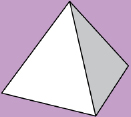Module 4
1. Module 4
1.19. Page 2
Module 4: Area
Get Started
In the following Try This activity you will examine nets for three-dimensional objects, such as the cube, rectangular prism, pyramid, and face.
net: a two-dimensional (2-D) pattern used to create, by folding and joining, a three–dimensional (3-D) object
cube: a rectangular prism for which all faces are identical squares

rectangular prism: a 3-D object for which all the sides are rectangles
A cardboard box is an example of a rectangular prism.

pyramid: a 3-D object having a polygonal base and triangular sides with a common vertex
The following is an example of a prism.

face: a 2-D side of a prism
The first net you will explore is a net for a cube or rectangular prism.
 Try This
Try This

tackle box: © operative401/shutterstock, tool box: © Robert Spriggs/shutterstock, jewelry box: © Anton Derevschuk/shutterstock,
shoe box: © Andrei Nekrassov/shutterstock, cardboard box: © mates/shutterstock
Find a cardboard box—any rectangular prism or cube will do. For example, a cereal box, small raisin box, or shoe box.
Examine the 3-D object’s sides, and mark each side with an X. Pull the box apart. If possible, keep all the sides you marked with an X attached, and rip off any pieces you did not mark. Lay the pieces flat—what you now have is called a net.
Depending on how you unfold the cube or rectangular prism, the net could look like any of the following examples.

There are 11 nets altogether that are possible. Sketch as many of the other nets as you can.
